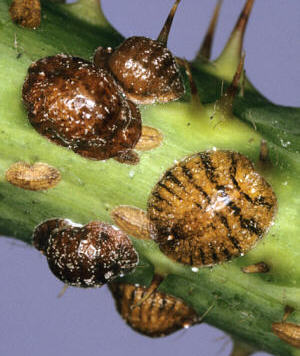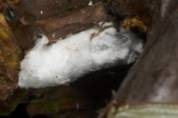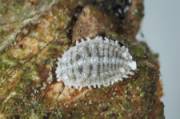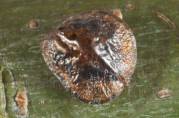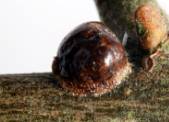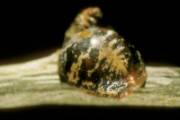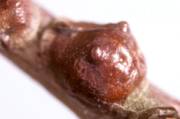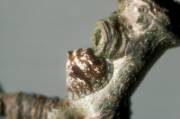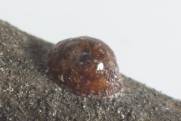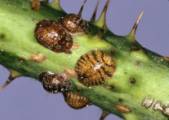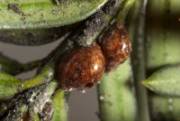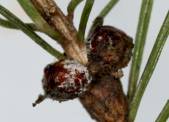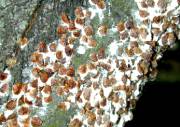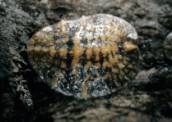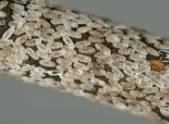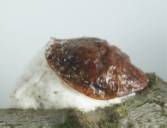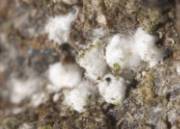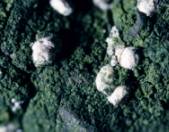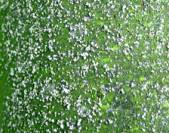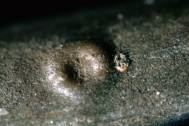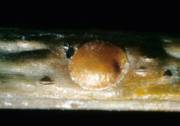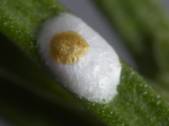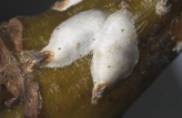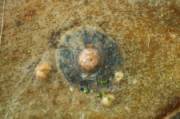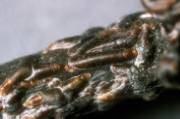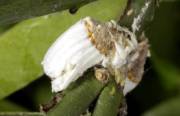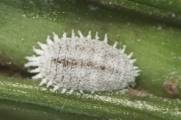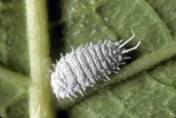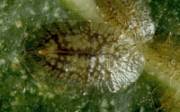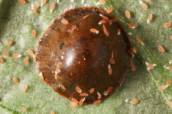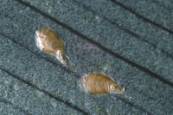 |
||||
Scale Insects (Sternorrhyncha)
| On-page links: | ||
Scale insects are plant-sap feeding insects, closely related to the aphids, whiteflies and jumping plant lice or psyllids.
They are among the most highly specialised of all plant parasites and feed on all parts of the plant including the roots, stems, leaves, buds and fruit.
The adult females do not look like typical insects as they retain the immature external morphology at sexual maturity.
Adult males, however, resemble small flies but never feed and die within a day or two of emergence.
Twenty-two species of scale insect belonging to six families have been recorded in Bedfordshire; the majority collected by the author between 1992-5 when he lived in Luton (collection details will be published in a separate article). Fourteen of the species recorded in Beds are native, two are naturalized introductions, and six are introduced species established on indoor plantings. This may, however, represent only half of the species that are actually present in the county. For comparison, the author has recently recorded thirty five native, four naturalized introductions and twenty four introduced species established on indoor plantings in Yorkshire. Although Yorkshire covers a much larger area, it is located further north where a lower number of species would be expected to occur.
Exotic scale insects are regularly dispersed between countries as a consequence of trade and are one of the most successful arthropod groups in terms of invading new geographical areas. Climate change also appears to be having an influence on the distribution of scale insects within Europe, as species once restricted to the Mediterranean are expanding their range into more northerly latitudes. Several exotic species have appeared in Greater London in recent years and it is probably just a matter of time before they expand their range northwards to Bedfordshire.
Under-recording of native scale insect species in Bedfordshire and the potential for the introduction of exotic species means that there is plenty of scope for recording species new to the county or even the country. Unfortunately the lack of easily accessible literature on scale insects can be a deterrent to their study so brief descriptions and photographs of all the scale insect species recorded in the county so far are provided below. Scale insects are found by careful examination of plant material and may be observed throughout the year on woody hosts. I hope that this information will encourage the recording of this fascinating group of insects as some of the common and/or most distinctive species can be identified in the field. Positive identification of most species, however, requires microscopic examination of slide mounted adult females and it is always advisable to retain voucher specimens.
Twenty-two species of scale insect belonging to six families have been recorded in Bedfordshire; the majority collected by the author between 1992-5 when he lived in Luton (collection details will be published in a separate article). Fourteen of the species recorded in Beds are native, two are naturalized introductions, and six are introduced species established on indoor plantings. This may, however, represent only half of the species that are actually present in the county. For comparison, the author has recently recorded thirty five native, four naturalized introductions and twenty four introduced species established on indoor plantings in Yorkshire. Although Yorkshire covers a much larger area, it is located further north where a lower number of species would be expected to occur.
Exotic scale insects are regularly dispersed between countries as a consequence of trade and are one of the most successful arthropod groups in terms of invading new geographical areas. Climate change also appears to be having an influence on the distribution of scale insects within Europe, as species once restricted to the Mediterranean are expanding their range into more northerly latitudes. Several exotic species have appeared in Greater London in recent years and it is probably just a matter of time before they expand their range northwards to Bedfordshire.
Under-recording of native scale insect species in Bedfordshire and the potential for the introduction of exotic species means that there is plenty of scope for recording species new to the county or even the country. Unfortunately the lack of easily accessible literature on scale insects can be a deterrent to their study so brief descriptions and photographs of all the scale insect species recorded in the county so far are provided below. Scale insects are found by careful examination of plant material and may be observed throughout the year on woody hosts. I hope that this information will encourage the recording of this fascinating group of insects as some of the common and/or most distinctive species can be identified in the field. Positive identification of most species, however, requires microscopic examination of slide mounted adult females and it is always advisable to retain voucher specimens.
Native and Introduced Naturalised Species
PSEUDOCOCCIDAE Mealybugs
Polyphagous tree mealybug Phenacoccus acerisAdult female oval, greenish yellow, covered in white to grey mealy wax, with 18 pairs of short marginal wax filaments; up to 4.3 mm long. This species occurs widely in Britain and is locally common. It is broadly polyphagous on woody plants and an occasional pest of ornamental and fruit trees. In Beds it has been found in Dunstable Downs, Luton, Luton Hoo and Sandy on hawthorn, ivy and sycamore.
COCCIDAE Soft scales
Currant soft scale Eulecanium douglasiAdult female, oval, convex, anteriorly rounded, posteriorly flattened, yellowish-brown to dark brown, shiny; up to 9.0 mm long; it is highly variable depending on the host species. This species is rarely recorded in Britain. It is polyphagous on woody plants and in Beds it has been found in Luton on a plum tree.
Nut scale Eulecanium tiliae
Adult female, oval, strongly convex, yellowish-brown to dark brown, shiny; up to 6.5 mm long. This species is widespread and locally common in Britain. It is broadly polyphagous on woody plants, particularly on Rosaceae, and occasionally enormous populations develop that damage woody ornamentals and fruit trees. In Bedfordshire it has been found in Dunstable Downs, Luton and Whipsnade; on apple, hawthorn and hornbeam.
Bituberculate scale Palaeolecanium bituberculatum
Adult females oval, convex, with two pairs of knob-like tubercles, the anterior tubercles much larger and more prominent than the posterior ones, reddish-brown; up to 8 mm long. This species occurs widely in Britain but is rarely recorded. It is polyphagous on woody plants, particularly on Rosaceae. In Bedfordshire it has been found in Dunstable Downs, Luton and Sharpenhoe on hawthorn.
European fruit lecanium Parthenolecanium corni
Adult females variable in shape, size and colour; usually oval, strongly convex, brown; up to 6.5 mm long. This species is locally common throughout Britain. It is broadly polyphagous and is an important pest of orchard, ornamental and forestry trees. In Bedfordshire it has been found in Luton and Sandy; on firethorn and honeysuckle.
Yew scale Parthenolecanium pomeranicum
Adult females broadly oval, somewhat tapering at both extremities, strongly convex, shiny dark or reddish brown; up to 5 mm long. This species occurs widely in Britain, but is rarely recorded. It feeds on yew and in Bedfordshire it has been found in Sandy and Swiss Cottage.
Small spruce bud scale Physokermes hemicryphus
Adult females bud-like, shiny, dark or reddish brown; up to 4.5 mm long. This species occurs widely in Britain, but is rarely recorded. It feeds on spruce and in Bedfordshire it has been found in Luton and Luton Hoo.
Horse-chestnut scale Pulvinaria regalis
Adult females oval, moderately convex, grey or brown with transverse pale and dark stripes, becoming uniform dark brown with maturity; up to 10 mm long. Ovisac forms beneath female body, which is tilted upwards; ovisac convex, white, about 7 mm long. This species probably originates in Asia, but has become widespread in central and northwest Europe since the 1960s. It is broadly polyphagous on woody plants. It is the most common coccid in urban areas throughout most of Britain but also occurs at low densities in rural areas. In Bedfordshire it has been found in Bedford, Bigglesworth, Caddington, Dunstable, Flitwick, Leighton Buzzard, Luton, Luton Hoo, Sandy, Swiss Cottage and Whipsnade; on bay laurel, elm, ivy, horse chestnut, lime, maple and sycamore.
Woolly vine scale Pulvinaria vitis
Adult females oval, moderately convex, with transverse wrinkles, dark brown; up to 9 mm long. Ovisac forms beneath female body, which is tilted upwards; ovisac strongly convex, white, about 8 mm long. This species is locally common throughout Britain and feeds on a wide range of woody plants. It is an occasional pest of grapevine, peach and currants. In Bedfordshire it has been found in Luton, Luton Hoo and Sandy on hawthorn.
ERIOCOCCIDAE Felt Scales
Beech scale Cryptococcus fagisugaAdult female body covered by cream coloured cottony wax secretion; about 1 mm long. It occurs throughout Britain on beech, frequently in very high densities. This species is associated with the transmission of beech bark disease. In Bedfordshire it has been found in Luton, Luton Hoo, Sandy, Swiss Cottage and Whipsnade.
Ash bark scale Pseudochermes fraxini
Adult female covered by cream coloured felt-like ovisac; about 1 mm long. This species occurs throughout Britain on ash, frequently in very high densities and often becomes a pest in urban areas. In Bedfordshire it has been found in Dunstable Down, Luton, Luton Hoo, Swiss Cottage and Whipsnade.
ASTEROLECANIIDAE Pit Scales
Golden pit scale Asterodiaspis quercicolaFemale test circular, slightly convex, greenish-yellow or yellow, translucent, with whitish marginal filaments; up to 1.6 mm in diameter. This species is common throughout Britain on oak and is an occasional pest. In Bedfordshire it has been found in Luton, Luton Hoo, Sandy and Swiss Cottage.
DIASPIDIDAE Armoured Scales
Minute cypress scale Carulaspis minimaAdult female cover convex, circular to oval, white; exuviae central, yellow; up to 1.3 mm long. This is a Mediterranean species that feeds on Cupressaceae and is locally common in southern England. In Bedfordshire it has been found on Leyland cypress in Sandy.
Willow scale Chionaspis salicis
Adult female cover convex, oyster-shell shaped, white; exuviae marginal, yellowish brown; up to 3 mm long. This species is very common and widespread in Britain. It is broadly polyphagous and often a pest of forest and ornamental trees and of currant bushes. In Bedfordshire it has been found in Bedford, Luton, Luton Hoo, Sandy, Swiss Cottage and Whipsnade; on ash, willow, lilac and lime.
Zonate armoured scale Diaspidiotus zonatus
Adult female cover circular to broadly oval, strongly convex, grey, brown or grayish-black; exuviae sub-central, orange; up to 2.8 mm long. This species occurs widely in Britain on oak but is rarely recorded, possibly because it is highly cryptic. This species is often completely hidden beneath the upper epidermal layers of its host. In Bedfordshire it has been found in Luton.
Mussel scale Lepidosaphes ulmi
Adult female cover elongate mussel-shell shaped, convex, brown, dark grey or black; exuviae terminal, orange to brown; up to 3.5 mm long. This species is very common throughout Britain, particularly on Rosaceae and is a serious pest of orchards, forest and ornamental trees. In Bedfordshire it has been found in Dunstable Downs, Luton, Luton Hoo and Sandy; on apple, cherry, hawthorn and whitebeam.
Introduced Species Established On Indoor Plantings
MONOPLEBIDAE Giant scales
Cottony cushion scale Icerya purchasiAdult hermaphrodites have bright orange-red, yellowish or brown bodies that are partially or entirely covered with yellowish or white wax; up to 6 mm long. They produce a large conspicuous fluted egg sac that may be two and a half times longer than the body. This species has recently become naturalized in the London area and is broadly polyphagous, although it may be restricted to indoor-plantings in Bedfordshire. It has been found at a nursery in Sandy on lemon plants imported from Portugal, where it was breeding for several months.
PSEUDOCOCCIDAE Mealybugs
Citrus mealybug Planococcus citriAdult female oval, grayish, often with a mid-dorsal longitudinal darker stripe, lightly covered in a layer of mealy wax, with 18 pairs of short marginal wax filaments; body length up to 2.5 mm long and 1.5 mm wide. This is a cosmopolitan polyphagous pest that is very common on indoor plantings throughout Britain. In Bedfordshire it has been found in Luton on a money plant. Glasshouse mealybug Pseudococcus viburni
Adult female oval, pinkish or greyish, lightly covered in a layer of mealy wax, with 17 pairs of marginal wax filaments, the caudal pair may be up to half as long as the body; body length up to 2.5 mm long and 1.5 mm wide. It is broadly polyphagous and is a very common pest in Britain of ornamentals grown indoors and outdoors in sheltered situations. In Bedfordshire it has been found in Caddington on Carpobroctus, Graptopetalum bellum and a money plant.
COCCIDAE Soft scales
Brown soft scale Coccus hesperidumAdult females are oval, flattish, translucent pale-yellow to yellow-brown, often mottled with brown spots; body length up to 5 mm and width 2.5 mm. This species is broadly polyphagous and a common, often serious pest of ornamental and crop plants in Britain. Although it is most commonly recorded on indoor plantings it also frequently occurs outdoors, particularly on bay laurel and ivy. In Bedfordshire it has been found in Caddington, Luton and Sandy on bay laurel, ivy, lemon and umbrella plant.
Hemispherical scale Saissetia coffeae
Post-reproductive females oval, hemispherical, smooth, glossy, yellowish-brown to dark reddish brown; body length up to 4.5 mm and width 4.5 mm. The nymphs and young adults have a distinct characteristic 'H' shaped ridge on the dorsum. It is very common on indoor plantings throughout Britain and is a broadly polyphagous pest of ornamental plants. In Bedfordshire it has been found in Caddington on spider plant.
DIASPIDIDAE Armoured Scales
Screwpine scale Pinnaspis buxiAdult female cover elongate pear-shaped, flattish, brown; exuviae terminal, orange to brown; up to 1.5 mm long. It is established at several botanical collections in Britain. It is broadly polyphagous but most commonly recorded on Palmae. In Bedfordshire it has been found at a plant nursery in Sandy on Cordyline imported from Costa Rica.
All images © Fera 2009
Further Reading
The scale insects and whiteflies
(Hemiptera: Coccoidea, Aleyrodidae) of Bedfordshire by C Malumphy
(the plates)
was published in The British Journal of Entomology and Natural History 23, 2010.
Reproduced here by kind permission of The British Entomological and Natural History Society.
| On-page links: | ||
